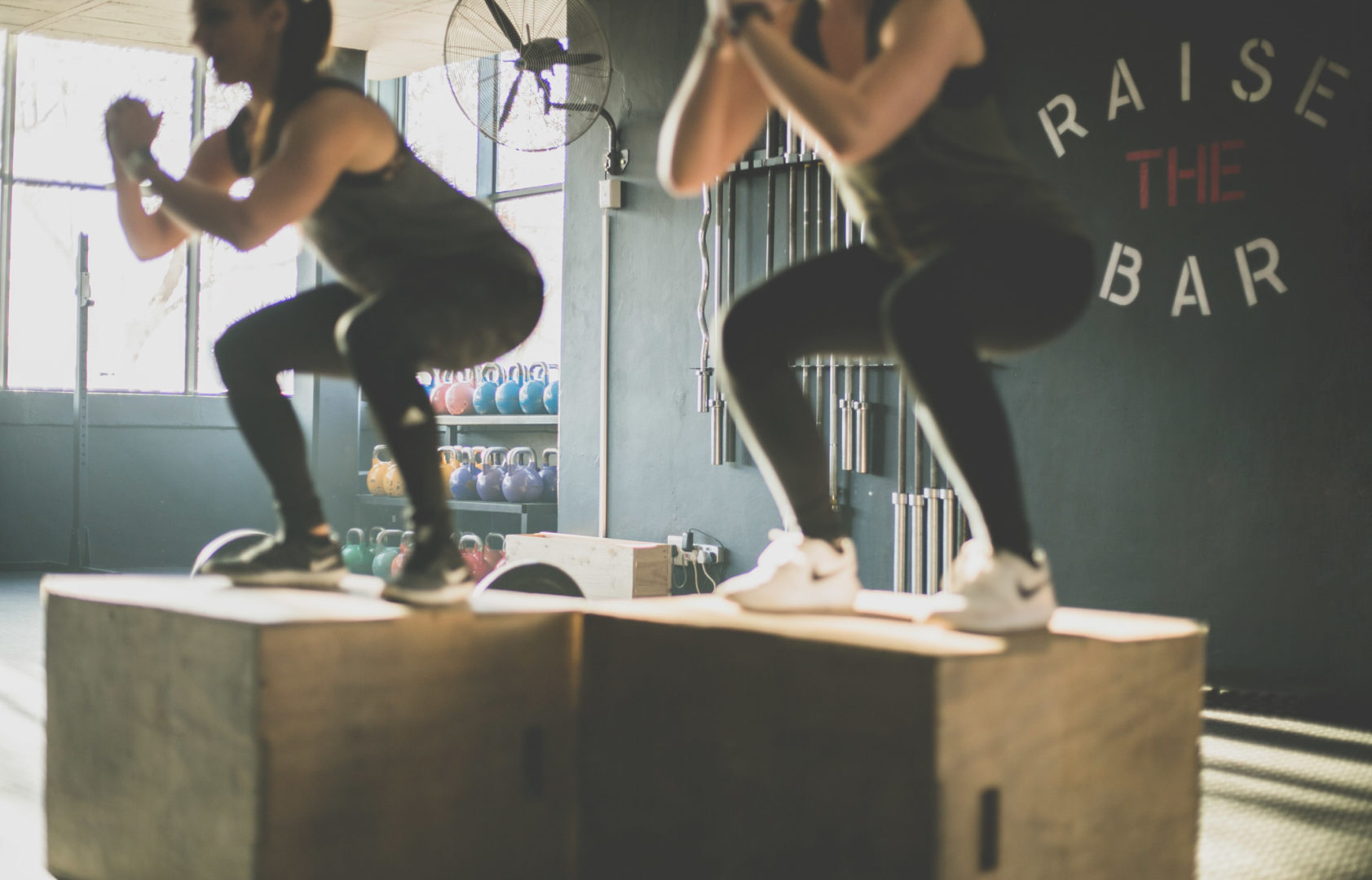
There are two big problems that people are dealing with these days. Many people deal with both, some only deal with one of them, but what’s most scary about these two problems is that not many people are doing anything about it. And these are both preventable and treatable problems! Ignoring them may work for a while, but eventually, you’re going to have to do something. So what are these issues I speak of? Let’s talk about it.
HOUSTON, WE’VE GOT A PROBLEM….
Posture
The conversation about posture is louder than ever these days. For decades, our culture has spent hours upon hours hunched over a desk. First with pen and paper, then with a typewriter, then a computer screen, and now we’ve gone all out with a computer, iPad, cell phone, and probably 3 other gadgets I’m just not yet hip on! In addition, we’ve taken this one step further by constantly staring down at our cell phones during almost every activity we do. Try walking down the street and counting how many people out of every 10 you see that are staring down at their phone. It’s terrifying. And you’ll probably be doing it too. (I know I do!)
To say that this new lifestyle has affected us is an understatement.
Back Pain
Back pain affects people of all ages, backgrounds, and walks of life. Sometimes it’s due to previous injury, other times it’s the result of weaknesses, and oftentimes it’s a result of one’s lifestyle (like the posture problem above).
I mentioned that both of these problems are both preventable AND treatable in many cases. You can minimize or ever reverse the problems with just a little bit of consistent work.
So what can you do to combat these problems?
TODAY WE’RE TALKING ABOUT BACK STRENGTH.
Being that your back is the primary support for your spine, it’s a really important part of the body to discuss. Having a strong back is essential in your ability to keep good posture, move properly, and alleviate pain (among other benefits). While having a strong back alone won’t fix your problems (your body is synergistic and it all works together) it is a very common weakness that we see all too often. It could very well be the missing puzzle piece to improving your ability to move, reducing or eliminating pain, and allowing your natural posture to be restored.
Now that we know why it’s important to have a strong back, how do you do it?
There are several muscles that make up your back. Some of the major ones are your latissimus dorsi (“lats”), rhomboids, trapezius, infraspinatus, teres, and erector spinae.
I’m sure you don’t care about that, but it’s good to know that you have a lot going on “back” there! (Yes, I’m a comedian too. Not necessarily a good one. ;-))
In order to work these muscles, there are different exercises you’ll want to do. While one exercise might work your lats really well, it may not hit your erectors much. Conversely, there are exercises that will hit your erectors and not give you much lat work. We’ve put together some of our top back exercises that will allow you to work your entire back. We’ve also included some commons mistakes we see with them that you’ll want to avoid. Please note: some of these “mistakes” aren’t necessarily wrong, they are just not correct for the purpose of working your back muscles and may be more beneficial when training another body part.
As always, if you’re not sure, ask one of the IRON Personal Trainers for help.
Please check with a doctor before starting any new exercise program, especially if you have past or current injuries or illnesses.
IRON’S TOP BACK EXERCISES
Lat Pulldowns
How to do them: While there are several different attachments you can use, the basic lat pulldown is done using a long bar. Place your hands on the bar at about shoulder width (or slightly wider) distance apart. The wider you go, the more you’ll rely on your lats. If you stay narrower, you’ll still use your lats but will work the back more evenly. Go with the width that feels best for you. Make sure your knees can fit comfortably underneath the pads and sit down on the seat with your arms overhead. Stick your chest out slightly and pull the bar down towards the top of your chest, imagining that you’re driving down with your elbows and squeezing your shoulder blades together. Make sure you’re in control of the weight from start to finish and not “jerking” the weight down nor letting the weight pull your arms back up.
The Right Way:

The Wrong Way:
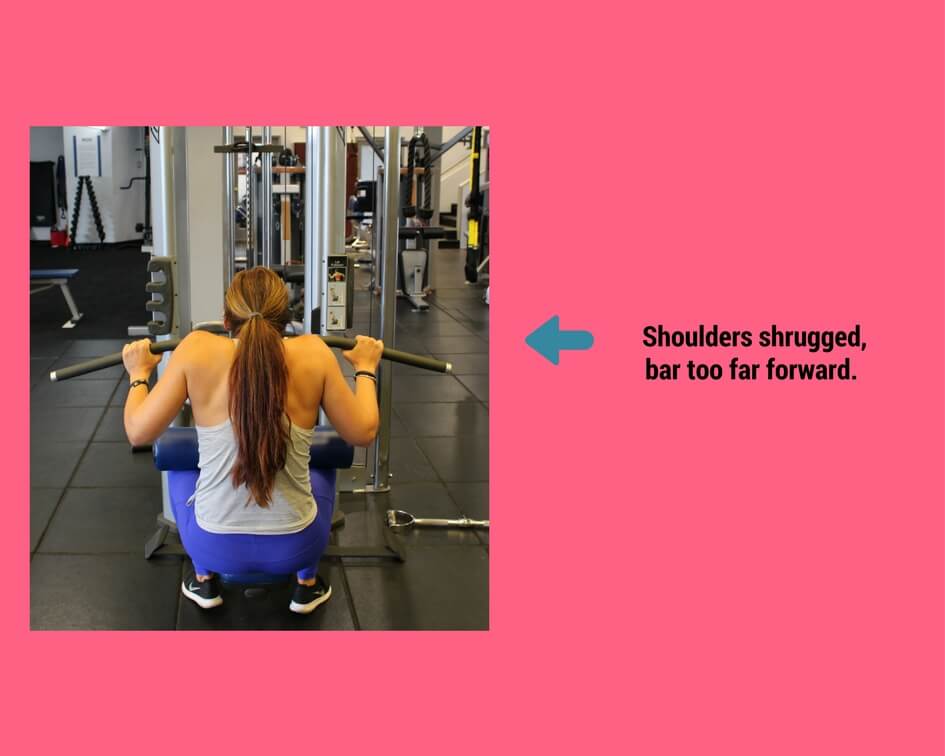
Seated Cable Row
How to do them: Once again, there are several handles you can use, but the basic v-shaped handle is most common. Start by placing your feet on the foot pads and grabbing the handle with both hands. Scoot back slightly until you have a slight bend in your knees. Sit up tall with your chest out, shoulders back and down, and arms straight out in front of you. From here, you’ll pull back until the handle comes to your chest and then slowly let the weight go back until your arms are straight again. Once again, you’ll want to focus on driving with your elbows and squeezing your shoulder blades together.
The Right Way:

The Wrong Way:
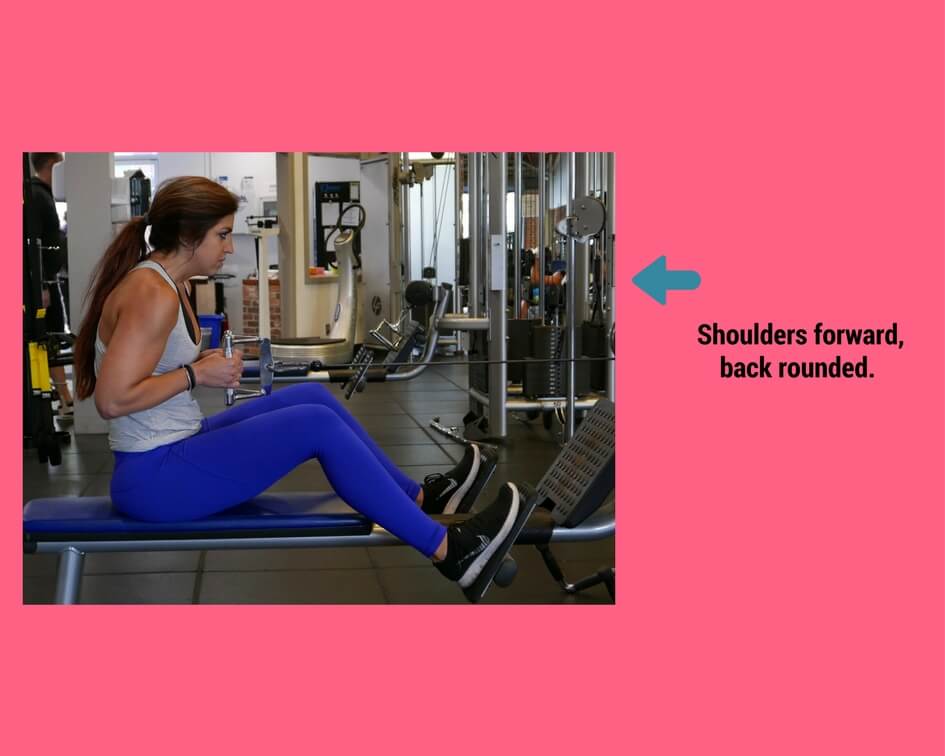
Bent Over Row
How to do them: Grab a set of dumbbells and stand with your feet about shoulder-width apart. From here, hinge forward from the hips while keeping a flat back, your chest out, and your shoulders back and down . Simply let your arms hang down below you and then pull the dumbbells up by squeezing your shoulder blades together. Once again, think about pulling the weight with your elbows (not your hands) in order to engage your back. You don’t need to bring your elbows up high, you just need to get a good squeeze in your back. Slowly release the dumbbells back down and repeat.
The Right Way:
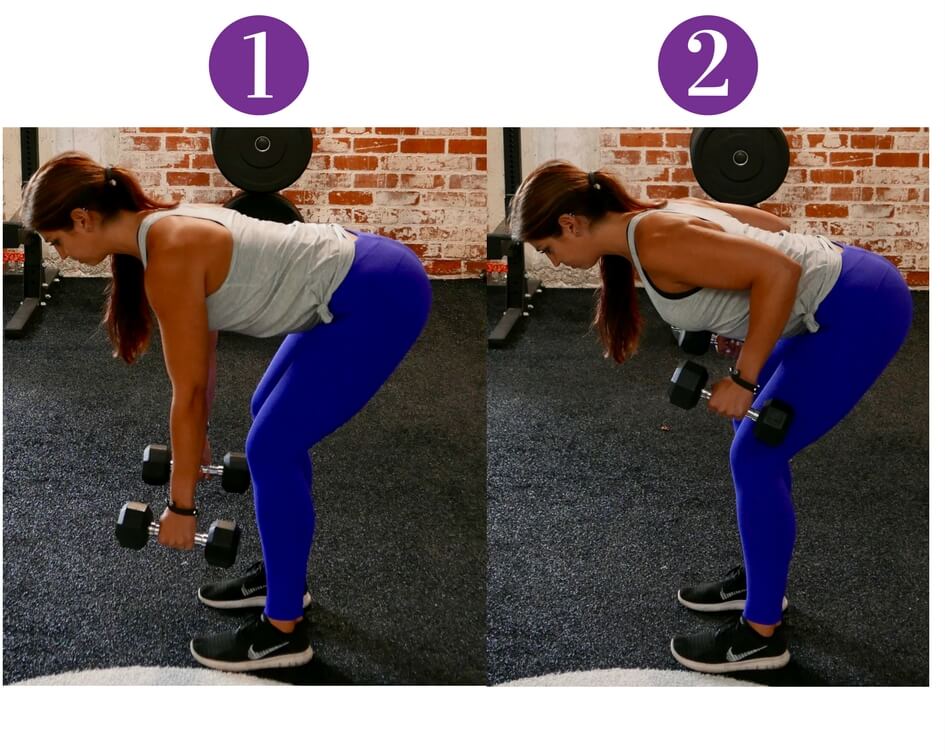
The Wrong Way:

One Arm Dumbbell Row
How to do them: Get in a 3-point stance with your feet staggered and one hand on a bench. If you’re starting with your right side, you’ll have your left hand on a bench, and your right foot will be further back than your left. Make sure you’re in a solid, stable position before you start. From here, you’ll drive your right elbow back and imagine pulling it towards the middle of your spine. Again, your elbow doesn’t need to come up high. Slowly lower your arm back down and repeat.
The Right Way:

The Wrong Way:

TRX Row
How to do them: Ensure the height of the TRX handles is sufficient before starting. From here grab the handles and walk yourself down as low as you can go. The lower you are, the more difficult it will be. Start out conservatively and if needed, you can always walk down lower. When you’ve found your bottom position, you’ll want to start with straight arms, chest out, shoulders back and down and your hips up. Your knees can be bent or straight (straight legs makes the movement more difficult). From this position, pull your body up towards the ceiling until your hands are are your sides and then slowly lower yourself down to the starting position.
The Right Way:
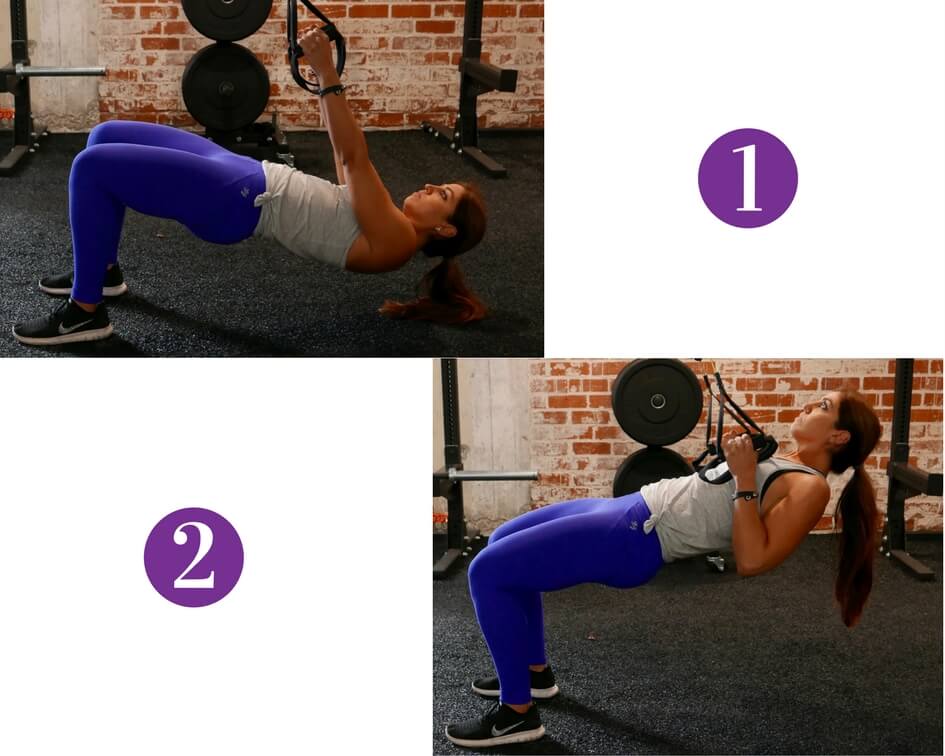
The Wrong Way:

Cable Rope Straight Arm Pulldown
How to do them: You’ll want to use either a rope or a straight bar attachment for this exercise and you’ll want the cable on the tallest setting above your head. From here, walk out a few steps, bend your knees into an athletic stance and keep your arms straight and next to your ears. You can have a slight bend in your elbow (locked out is usually not a good position) but you’ll want to keep that slight bend throughout the entire movement without bending it any further. Start the movement by pulling the rope down towards your thighs and squeezing your lats when you get there. Slowly allow the cable to retract as your arms go back up and repeat.
The Right Way:

The Wrong Way:
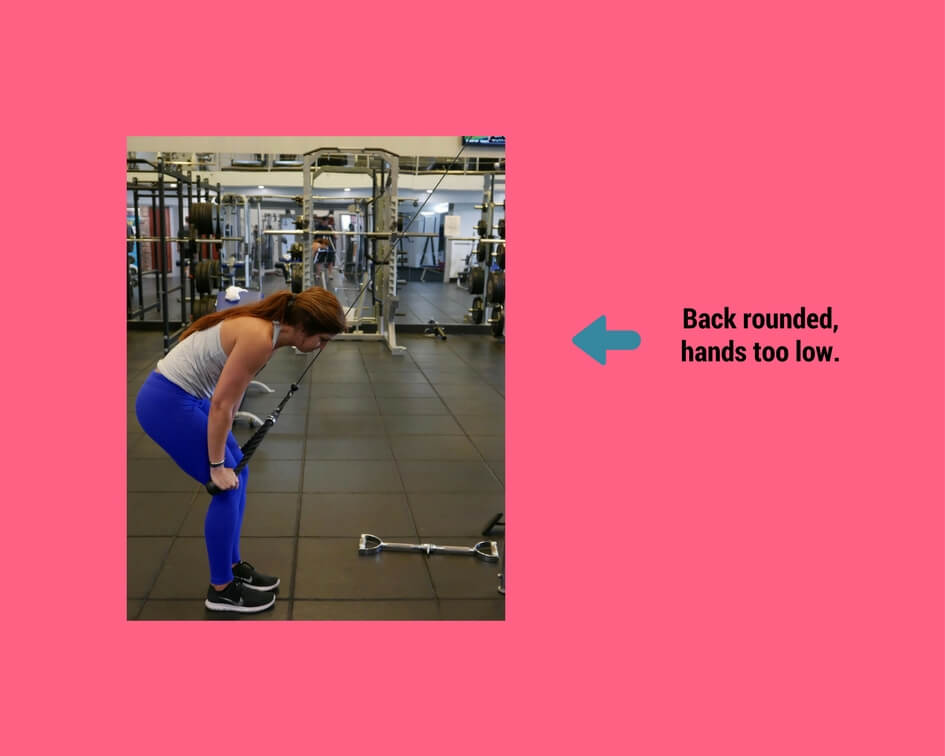
Cable Rope Face Pull
How to do them: You’ll want to use a rope attachment for this exercise and to set the cable up so that it’s about shoulder height. From here, step back a few steps with your arms straight out in front of you. From here, drive your elbows back and pull your hands just outside of your ears. Be sure that your elbows are also up high and in line with your ears. Slowly let the cable retract until your arms are straight again and repeat.
The Right Way:
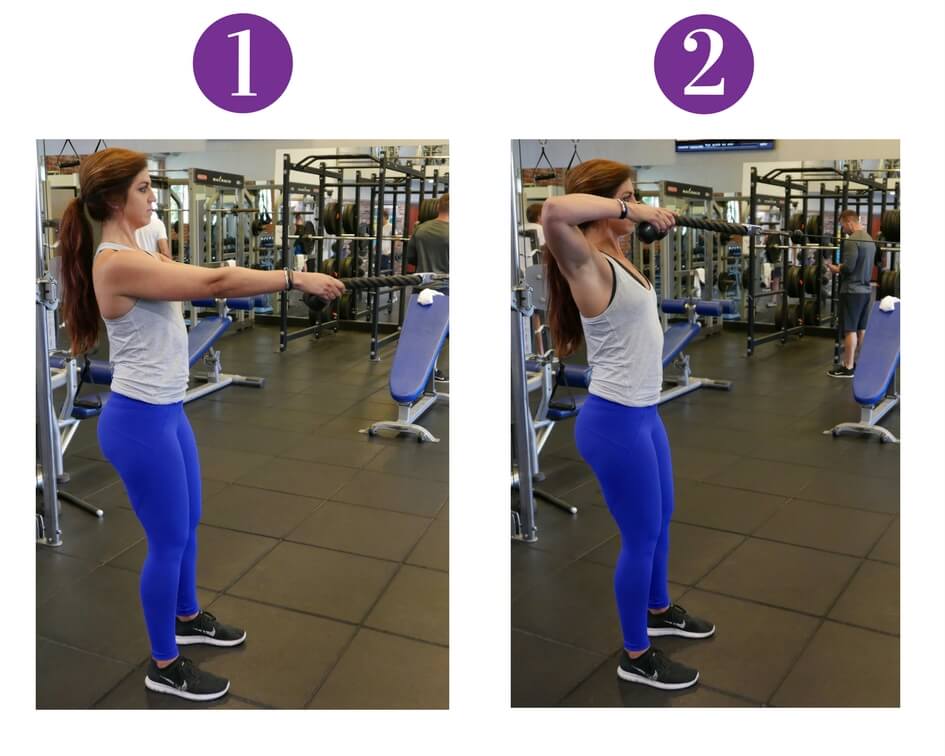
The Wrong Way:

Pull-Ups/Chin-Ups (no video/photos)
How to do them: You can do these either assisted or unassisted, depending on your strength level. Start with your hands about shoulder width apart overhead and with either a pro-nated grip for pull-ups or a supinated or neutral grip for chin-ups. From a dead hang, retract your shoulders back and down and pull your body up and over the top of the bar. Just like the lat pulldown, you’ll want to pull your upper chest towards the bar and keep your chest out to ensure the movement stays in your back and arms. Slowly lower yourself down and repeat.
Now that you know what they are and how to do them, WHEN you should do them?
We’ve got ya covered. Include this back workout into your program and you’ll be sure to see results in just a few short weeks!
YOUR WORKOUT PROGRAM
You can either perform all of these exercises in one workout each week OR split it up and do half of them on 1 day and the other half on another. If you’re doing them all in one workout, we recommend doing 2-3 sets of each. If you’re splitting it up, you could do 2-4 sets of each. Know your own fitness level and determine what’s best for you. If you’re not sure, we’re here to help.

For pull-ups or chin-ups, your rep range will vary based on whether you’re doing assisted or unassisted + your strength level.

